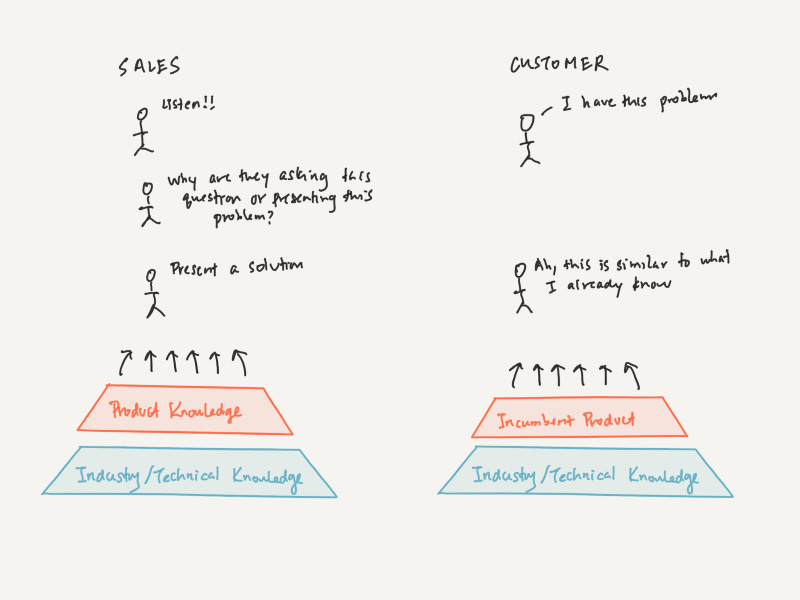How learning to sell makes for a better product manager
Some of the most valuable lessons I’ve learned at Cockroach Labs have been from selling or watching other people sell CockroachDB. As…
Some of the most valuable lessons I’ve learned at Cockroach Labs have been from selling or watching other people sell CockroachDB. As product managers, we are often focused on building features that meet a user need, but a big portion of building a successful feature also involves knowing how to communicate it to customers both internally and externally. Good sales teams package distinct features into solutions that they can present to customers, and that skill of telling stories that are supported by features is a skill that every product manager should aspire to have.
When I first started out at CockroachDB, we didn’t have a sales team yet. This meant that I was lucky enough to tag along on early customer meetings and pitches, as well as work on early versions of our sales deck. At that time, we were very much focused on capturing early adopters — risk-tolerant customers who bought into our ultimate vision of a data architecture that abstracted away the complexity of scaling across multiple data centers.
As the company grew, the surface area of the product grew as well. My role adapted to cover just certain features within the overall product. Rather than listening in on pitches that sold the entire product, I would more often interface with customers to gather feedback on the features that I covered. It was in one of these meetings that I discovered how important it is for a product manager to understand how to sell to a customer (even if it isn’t a core competency).
I had just finished scoping out a new feature, and I wanted to check that the scope met customer needs before committing. The sales team helped set up a meeting where I could discuss the scope with a customer. I dove in immediately into the technical details of how the feature would be implemented, and what users would be able to do with it. After my monologue, I was met with dead silence. The customer hadn’t understood a word I had said, and we ended up having to backtrack to get back on the same page.
This rather embarrassing exchange led me to the understanding that all communication that occurs between customers (whether external or internal) is mired in context. By focusing on the “what” instead of the “why,” I had set myself up for failure at the start.
A Mental Model for Sales
I work with a sales team that I have exceedingly high respect for, and through observing them, I came up with a mental model of how to think about sales. Sales people have a bad reputation culturally that I don’t think I need to repeat, but I think this reputation is vastly unfair. Good sales people are solution-focused and customer-oriented — all good characteristics in my opinion.
As mentioned earlier, context is king. Everything a customer says is connected to some context or understanding they have about the problem they are trying to solve. The secret to communicating successfully with a customer comes in two phases: 1) understanding where they are coming from, and 2) presenting a solution that gets them to where they want to be.
In the first phase, understanding where a customer is coming from, it is important to listen first! While the customer is presenting their problem, a sales person (or a product person) should be thinking about what context has led the customer to ask this question or have this problem. Is there some industry trend that is driving this need? Is there an incumbent product that has a feature that addresses this need? Are they asking for a feature because another product has it, and can their problem be solved in another way?
In the second phase of presenting a solution, it is also similarly important to remember context. Help the customer by presenting the solution in the context of their existing knowledge. It is also really important to know the product well enough to pull from that knowledge in order to present a solution that makes sense.
Applying this Mental Model to Product Management
So how does this relate to product management in general? Let’s talk about how we can apply this mental model to both external and internal situations where product managers have to communicate the benefits of features they are working on.
We already touched on how focusing on customer context would have helped me better present the feature I was working on, and get better feedback as well. If I had focused on why the customer needed the feature and presented my new feature with added context of how it fit into what the customer was already familiar with, I wouldn’t have been met with silence and confusion. The same thing goes internally — when presenting an idea for a new feature, it is important to provide context, and take into account what your audience is familiar with.
This framework of creating a story or providing context around features is also helpful for roadmap building and product marketing. For a given user story, what features can meet that need? How can we wrap existing features into a cohesive story to meet that need? What additional features would strengthen that story?
At the end of the day, working with the sales team has taught me how important context is when communicating with both internal and external customers. I can’t say I’ve really mastered this yet, but practice makes perfect!



